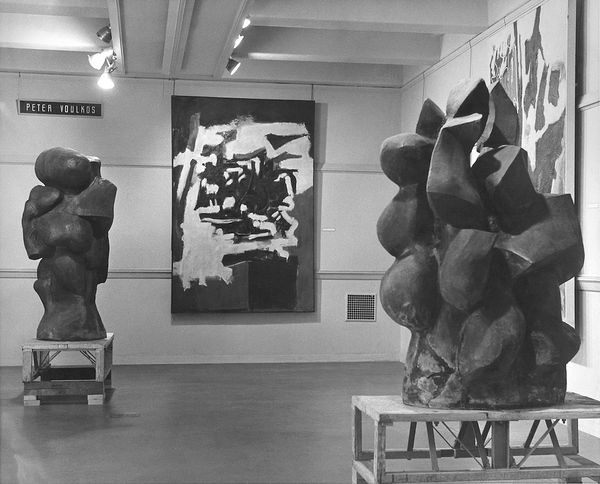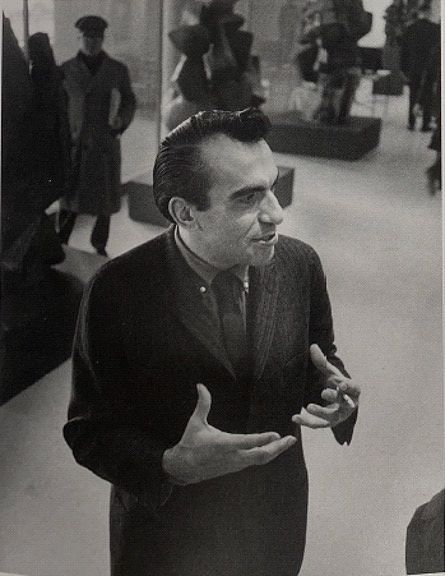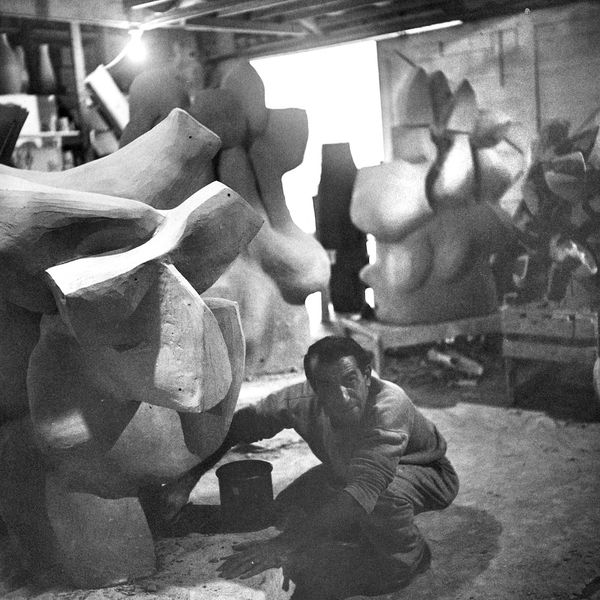Peter Voulkos in his Glendale Blvd. studio with Black Bulerias in the background, 1958. © Pier S. Voulkos and Daniel R. Peters Trust, Photography by Rose Slivka. Courtesy of the Voulkos & Co. Catalogue Project.
Written by Glenn Adamson
Imagine you are Peter Voulkos in 1958. Here is what is on your mind. First and always, the landscape of Montana, where you were born and raised: the sublime power of that terrain, the drama of the cragged mountains and the passes cutting through. Second, the potential of clay as a sculptural medium, which you have been thinking about constantly—not abandoning your hard-won potter’s skills, but redeploying them in wholly unconventional ways. Third, an ever-enlarging constellation of artists, among them Pablo Picasso, Fritz Wotruba, and Franz Kline, as well as the more immediate energies of the Los Angeles scene (notably, the gang at the experimental Ferus Gallery, now in its first year of programming). Fourth, the new possibilities of scale afforded by your new Glendale Boulevard studio, with its oversized kilns, which you share with a fellow artist, John Mason. The architectonic quality of Mason’s work is itself a fifth element—a level of ambition for you to match, blow for blow.

Peter Voulkos, Black Bulerias, 1958. Estimate $600,000-800,000. Design New York.
Now imagine you want to combine all of these disparate influences into a single artwork. And, finally, that you succeed. This is Black Bulerias. All of Voulkos’ ambitions are present in this powerful work: geological force, medium-specific innovation, monumentality, sculptural intelligence, and structural complexity. Its importance derives partly from the circumstances of its making. In 1958, the artist was just arriving at the summit of his career—a short period that lasted only for another two years, when he was obliged to leave Los Angeles behind to teach in Berkeley. While he did continue to make ceramics in the Bay Area, alongside a new body of work in bronze sculpture, never again would he achieve the combination of scale and experimentalism that he did in these few years. Black Bulerias is one of very few major examples from this period that has remained in private hands, and has an extraordinary provenance to boot. Voulkos clearly considered it one of his most significant works; it was one of three that he sent to the 1959 Paris Biennale, where he won the Rodin Museum Prize, and was also included in his one-man exhibitions at the Pasadena Art Museum in 1958-59, and the Museum of Modern Art, New York in 1960.

Black Bulerias installed at the Pasadena Art Museum, 1958. © Pier S. Voulkos and Daniel R. Peters Trust, Courtesy of the Voulkos & Co. Catalogue Project.
Despite the historical gravitas of Black Bulerias, its physical mass, and the sheer willpower that Voulkos brought to making it, the composition also feels—the only word for it—playful. This quality is signaled in the title, appropriated from the vocabulary of flamenco guitar music, which he studied avidly (the bulería is a fast dance form, described as “bustling, happy and cheerful”). The sculpture rises from its two rounded haunches into a tumble of forms, an upward avalanche. It culminates in two craggy outcroppings, suggestive of fists raised in joy or triumph. The sculpture is marvelously changeable; as one circles around it, its interplay of positive and negative space develops into a muscular, propulsive rhythm.Despite its singular significance in Voulkos’ oeuvre, Black Bulerias does fit into a group of related works by the artist. In hindsight, it is also possible to see how it fits into a longer creative sequence. The immediate context for the work includes several other significant works, among them 5000 Feet (now at LACMA), Burnt Smog (also known as Funiculated Smog, in the collection at Frank Lloyd Wright’s Fallingwater), Rasgeado (not to be confused with the earlier work of that title, now in a private collection), Black Butte Divide (Norton Simon Museum of Art), and Flying Black (also private collection). While none of these have quite the presence or complexity of Black Bulerias, all are executed in a similar idiom, made in stoneware with a dark slip or glaze, and built out of discrete volumes which are quasi-integrated into a fragmentary form.

Peter Voulkos, Black Bulerias, 1958. Estimate $600,000-800,000. Design New York.
The effect of these works was aptly described by Gerald Nordland in a rapturous review of Voulkos’ Pasadena Art Museum exhibition: “one considers the pot-like nature of the material and begins to feel vaguely with the weight, the suggestion of a figure which never emerges...The individual forms grow together and apart, creating spatial tensions and balancing each other in a personal exploration of the exuberance of sculptural form.”1 As Nordland acknowledges in this passage, the technical basis for this group of sculptures—despite their groundbreaking character—is still the lexicon of pottery. Each component of Black Bulerias is made from wheel-thrown and slab elements, and is more or less vessel-sized. Voulkos had been experimenting with altered pot forms for a couple of years already; his breakthrough at this moment was to realize that these components could be reconceived as building blocks, opening a whole new sculptural vocabulary.

Peter Voulkos, Black Bulerias, 1958 (detail). Estimate $600,000-800,000. Design New York.
Over the subsequent decade, Voulkos would redeploy this modular approach in several different ways. A series of great masterworks he produced in 1958-1959, including Rondena (sold at Phillips in 2017), Sitting Bull (Santa Barbara Museum of Art) and Little Big Horn (Oakland Museum of California), are built in much the same way, with the exterior unified into an envelope. This topological surface then serves as a canvas for expressionist painting, in conversation with the oils on canvas he was producing at the time (see: "Tower of Power"). He went on to apply the idea of unit-based construction to bronze sculpture; this adoption of a new medium is often understood as a rupture from his preceding ceramic work, but it was to some degree a logical extension. Finally, there are the Blackwares of 1967-68, which have a more evident relationship to functional ceramic typologies—plates, vases, jars—but feature the same dark palette and modularity he had pioneered a decade earlier.2

Black Bulerias installed at the Museum of Modern Art, New York, 1960. © Pier S. Voulkos and Daniel R. Peters Trust. Digital Image © The Museum of Modern Art/Licensed by SCALA / Art Resource, NY.
Voulkos would never again be quite so generative again (though his later, wood-fired works do find many admirers). But during this short space of time—his breakthrough years—and especially in the key period from 1958 to 1960, he opened up the full possibilities of his medium for countless artists. These works have served as an essential framework of reference ever since.

Peter Voulkos standing in front of Black Bulerias and other works exhibited at his solo exhibition at the Museum of Modern Art, New York, 1960. © Pier S. Voulkos and Daniel R. Peters Trust. Photography by Simpson Kalisher, courtesy the Voulkos & Co. Catalogue Project.
To fully take the measure of Black Bulerias, then, we must see it not only as a triumphant milestone in Voulkos’ career. We should also see it as a site of convergence, in which several separate trajectories meet. In this respect, it is a fitting embodiment of the mountain landscape of his native Montana—which was compounded of primal forces beyond reckoning—and of Voulkos’ own studio, where numerous trains of thought collided to equally seismic effect. Black Bulerias has a duality that all great art works share in common. Perfectly, powerfully resolved in its own terms, it also points the way ahead.
1Gerald Nordland, “Art: Spokesmen for the Know-Nothings,” Frontier (May 1959), 22.
2 Glenn Adamson, “Back to Black,” in Voulkos: The Breakthrough Years (New York: Museum of Arts and Design, 2016.
Glenn Adamson is an independent curator and writer based in New York.
Discover More from Design New York >

Recommended Reading
Tower of Power: Peter Voulkos' 'Rondena' >
Understanding Antti Lovag's Palais Bulles >
